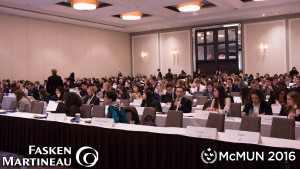SOCHUM adopts a more imperious approach to water crises

The Social, Humanitarian and Cultural Committee (SOCHUM) prolonged its discussion on hydro-diplomacy on Saturday and had developed six resolution proposals as the day ended. Hydro-diplomacy is intended to be a framework for global water management, to ensure drinkable water is accessible to all humans, regardless of their social-economic status. Not only does geographical location constrain the equal distribution, sustainability and quality of water, but the consequences of economic development, such as water pollution and climate change, can also alter the availability of water.
 Problems related to water are nothing new. In 1997, the Convention on the Law of the Non-Navigational Uses of International Watercourses was set up to address them, yet it only came into force in 2014. Moreover, only 36 parties and 16 signatories joined, a measly count on a global scale. It had therefore become urgent to come up with a more efficient plan. Were the six proposed resolutions up to the task?
Problems related to water are nothing new. In 1997, the Convention on the Law of the Non-Navigational Uses of International Watercourses was set up to address them, yet it only came into force in 2014. Moreover, only 36 parties and 16 signatories joined, a measly count on a global scale. It had therefore become urgent to come up with a more efficient plan. Were the six proposed resolutions up to the task?
Undoubtedly, they all acknowledged the severity of water crises worldwide, and they all proposed forceful solutions, such as the creation of a panel of independent judges to evaluate disputes on trans-border water distributions and the outlining of individual member states’ responsibilities during water crises, as well as any penalties that may have to be applied. However, looking into the clauses in detail, one finds that phrases attempting to “encourage member states to” do something and appealing to the “willingness of countries” repeatedly appear. With this language, one wonders if the final resolution might only turn into another futile effort at solving the issue, since the “willingness of countries” is beyond the control of the United Nations.
The ways in which this “lack of willingness” could influence proceedings was illustrated by the repeated proposal to endorse experts to research both scientific and political effects of water crises. It made it appear as if no comprehensive evaluation of the global situation of water existed. Another aspect that was relegated to the background was the diversity of geographical locations. Research and development into the artificial creation of water supplies and their preservation for underprivileged regions could have been a welcome addition to the debates.
All in all, it is good news that awareness was raised on water crises and that SOCHUM is becoming more imperious in dealing this problem. Whether or not its resolutions will fall into place and give relief to people around the world is another story.
Photo credits to McMUN/Philip Nguyen-Powanda
